► Porsche’s first EV gets tested long-term
► We drive the GTS Wagon
► Is it still competitive four years on?
I was lucky enough to be working for a PR agency with Porsche as our biggest client when Stuttgart unveiled the Taycan. So I got a peek inside the tent ahead of the unveil – not quite a full debrief from Mr Blume himself (as nice as he is, the closest I got to the big chief was calling him Oliver, much to my then boss’s consternation), but still a greater proximity to the momentum change than was available to most.
It’s fair to say our friends in Germany were absolutely cock-a-hoop with the car. Excited yet nervous anticipation would be a good description in the days before the covers were pulled back. Don’t forget how radical the car was at the time – EVs were around in 2019 but no one of Porsche’s ilk was getting anywhere near actually building one. And not only that, but Zuffenhausen pulled it off with all the engineering integrity and cutting-edge tech that was needed to justify putting a Porsche badge on an electric car.
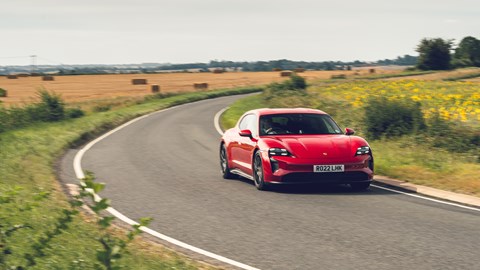
A global, simultaneous unveil across three continents with Mark Webber compering showed how much it meant to the company. Rave reviews followed, sales were huge, the electrification of the brand was on its way. And now we find ourselves as the proud custodians of a Taycan GTS Sport Turismo, an electric Porsche with both the usefulness and sportiness turned up. The children were just as delighted as me when it arrived a short while ago – in this job you get to experience plenty of rare metal, but having a Porsche as your daily transport is still quite a moment.
Initial impressions are that it delivers in spades on the balance of thrills and practicality – easy to relax into but with precise major controls that make it feel alive.
I believe that accessible thrills are crucial to a car’s success. Few people really have time to go out for a drive just for the hell of it, so a set of wheels needs to bring enjoyment to even the most routine journey. Porsche’s GTS variants have tended to deliver on this, sitting brilliantly between the continent-flattening pace of the Turbos and the tactility of the lesser models, so it bodes well that our Taycan is of that breed.
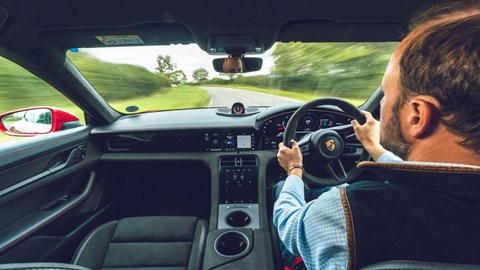
Plenty of people worry that electrically-assisted steering doesn’t deliver the feedback of a hydraulic system. And yes, you can’t say the Taycan has the beautiful fluidity of McLaren’s oil-based set-up. But it’s still very good. I’ve not had a journey yet where it felt anything like a poor relation.
To address the elephant in the room in this first report, you might wonder why we’re running one now, four years after the Taycan’s launch. The EV playbook has moved on quite a tick since then. But to me that’s the point of this test – is the Taycan still relevant? Does it offer something special even against newer options?
It needs to, given its price. I know that a lot of Taycans in the UK are company cars, because of the still barely believable benefit-in-kind rates EVs achieve. But still, £111,200 is a lot of cash in anyone’s book.
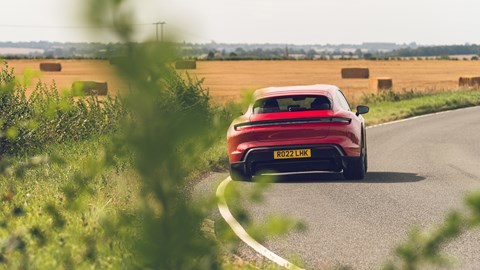
This particular GTS comes with over £15,000 worth of extras, including the paint (Carmine Red, £1851), a head-up display (£1128) and the GTS interior pack, also in Carmine Red, at £3102. We’re still pretty fresh into the loan so I can’t tell you yet how often I’ll use things like the 4+1 seats (£371), although the extra flexibility afforded by that small, fold-up central rear seat would seem to make it a must-have.
While browsing the options list, one thing jumps out: Porsche’s propensity for charging for things that just about everyone else would treat as standard-fit. How about an £89 grey-top tint on the windscreen? Rear-axle steering with ‘power steering plus’ intrigues me (£1815).
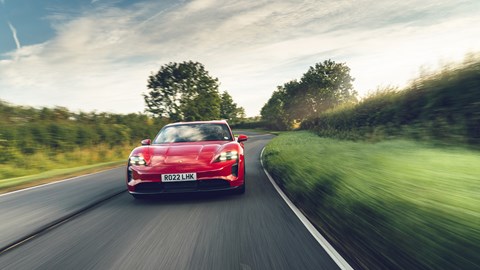
The Taycan seems compact when you’re in the driver’s seat and looking out on the road, helped by the seat going low and the wheel adjusting out towards you a long way. It’s alert and incisive. But in town, at least in my initial forays in the car, it lacks the manoeuvrability of some cars at this price point, despite the 2.8º rear-wheel steer. The Range Rover is bigger than the Taycan (although not by much; 5052mm versus 4963mm), but is a doddle to get into multi-storey car parks because of its 7.3º of rear-axle counter-steer. Maybe I’ll get used to the Porsche.
It’ll be interesting to see how practical the Taycan turns out to be. The boot isn’t enormous and the aperture is quite narrow, but I’m looking forward to a long, family-filled slog in it, possibly with a hound on board, to see how it copes.
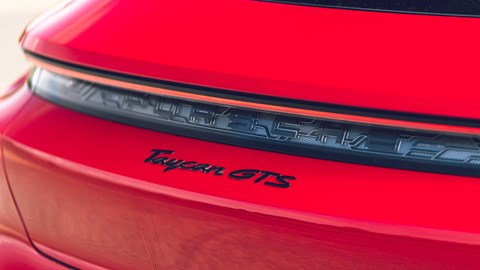
That’s the genius of the car, at least at this early stage. The potential it offers. Estate cars have always ticked a lot of boxes for me – an electric Porsche even more so.
Read month 2 here
Logbook: Porsche Taycan GTS Sport Turismo (Month 1)
Price £111,200 (£126,486 as tested)
Performance 83.7kWh battery, twin e-motors, 510bhp, 3.7sec 0-62mph, 155mph
Efficiency 2.93 miles per kWh (official), 3.06 (tested), 0g/km CO2
Range 301 miles (official), 240 miles (tested)
Energy cost 10p per mile
Miles this month 362
Total miles 13,842